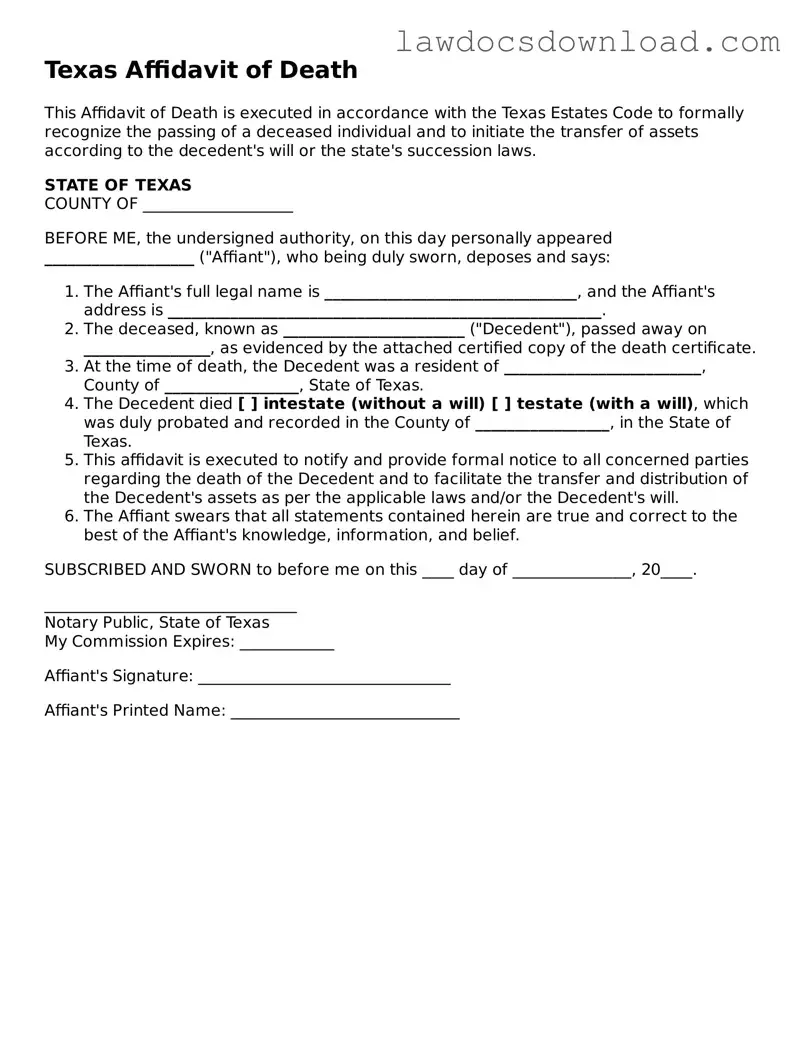The Texas Affidavit of Heirship is closely related to the Affidavit of Death, in that both are used to legally establish important facts about a deceased person. While the Affidavit of Death certifies the death of an individual, the Affidavit of Heirship goes further to identify the heirs of the deceased. This document helps in the transfer of property from someone who has passed away to their rightful heirs, providing a clear record for legal and financial institutions.
Similarly, the Death Certificate is an official government-issued document that proves the fact, date, and cause of a person's death. Like the Affidavit of Death, it is essential for various legal processes following someone's death, including the settlement of the deceased's estate, accessing pension benefits, and arranging for a funeral. Both documents serve as foundational proof of death but are obtained through different processes and authorities.
The Last Will and Testament is another document that often works in conjunction with the Affidavit of Death. This document outlines the deceased's wishes regarding the distribution of their estate and the care of any dependents. It becomes operative only upon the individual's death, making the Affidavit of Death a crucial initial step in validating the Last Will and initiating the probate process, where the estate is legally settled.
The Revocable Living Trust, while serving a different primary purpose, also interacts significantly with the Affidavit of Death. This estate planning tool takes effect during the grantor's lifetime but also contains directives for asset distribution upon their death. The Affidavit of Death signals the transition point where these instructions become actionable, as trustees can then begin to distribute assets as specified without the need for probate.
The Executor’s Deed is a legal instrument used by an executor of an estate to transfer property ownership as directed by the will or according to the state’s intestacy laws if no will exists. The Affidavit of Death is often required to confirm the executor’s authority to manage the deceased's assets, laying the groundwork for the property’s legal transfer through the deed.
The Joint Tenancy with Right of Survivorship Agreement defines a co-ownership structure for property where, upon one owner's death, that share directly transfers to the surviving co-owner(s). The Affidavit of Death is critical here, as it formalizes the end of the deceased's ownership interest, allowing the property to pass smoothly to the survivors without probate.
Transfer on Death Deed, similarly to the Joint Tenancy Agreement, bypasses the often lengthy and complex probate process by directly transferring property ownership upon death. The Affidavit of Death activates this transfer, formally notifying relevant parties that the property should now legally move to the named beneficiary.
A Power of Attorney document grants an individual the authority to make decisions on another's behalf, typically ending at the grantor’s death. The Affidavit of Death is thus necessary to officially conclude the Power of Attorney's effectiveness, ensuring that no unauthorized actions are taken posthumously.
The Beneficiary Designation form is commonly used with retirement accounts, life insurance policies, and other financial products to specify who will receive the assets upon the account holder's death. The submission of an Affidavit of Death to the financial institution or insurance company confirms the account holder's passing and initiates the transfer of benefits to the named beneficiary.
Lastly, the Trust Certification is a document used by trustees to prove their authority to manage a trust following the terms laid out by the grantor. After the grantor's death, the Affidavit of Death, alongside the Trust Certification, helps confirm the transition of control and the start of the asset distribution process in line with the trust's instructions.
